

O is for Overprint |
 |
 |
 |
 |
An overprint is any text, numerals, or design element added to an existing stamp,
thereby creating a new stamp. The new stamp may have a different value, a different
meaning, or even be for a different country.
Overprints are created for various reason. One - the most common one - is simple economy
- it's cheaper to add text on top of an existing stamp than to print totally new ones.
Another is the need for a new stamp quickly. It takes time to design a stamp, and have
printing plates made, and buy the paper, and print it, and gum it and perf it, so if
new stamps are needed in a hurry, overprinting stamps already on hand can be a quick
way to get them.
Probably the best-known overprints are the inflation overprints of
Germany after WWI. In the post-WWII period there were many overprints associated
with the transition from wartime to peacetime, and the re-establishment of local
governments in occupied areas such as Trieste. In the US there have
been only two uses of the concept, once as a security measure, and
later in a misguided attempt to economize in stamp production. Still
other examples of overprints are shown below.
O was not always Overprint - click here to see the original choice
German Inflation Overprints, 1922-1923
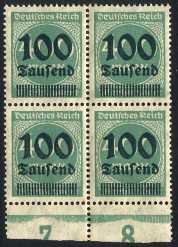


Probably the most notorious overprints are those of Germany in the period of hyper-inflation during 1922 and 1923. The stamps above tell the story. Early in the period, the underlying stamp at the top (Scott 202) was valued 400 Marks. Its face value was already hundreds of times more than such a stamp would have cost even a year earlier. Mere weeks later this stamp was overprinted 100,000 Marks (as shown), and mere months later overprints on generic undenominated backgrounds have values as high as 20 Billion Marks! Towards the end of the period, overprints were being printed on top of previous overprints - it was impossible for anyone to keep up with the skyrocketing inflation, probably the worst any country has ever known.
When I started collecting as a child, in the mid-
1950's, every world mixture I bought at the dime store was full of these stamps, and I
had little idea what they meant - they were just a nuisance, since I found them
unattractive, and they had little value. Later, when I studied World History, I heard
stories from my teachers about that time, one about a man who left his home with a
wheelbarrow full of money, hoping to buy a loaf of bread, but by the time he reached the
bakers, the money was worthless! Most of these stamps are still cheap and plentiful, but
they interest me today for their role in a critical period of recent history.
2/28/03 - Lars Boettger of Luxembourg wrote to add this poignant note:
Just a little piece of added information (or rather legend) about the wheelbarrow story:
When the man found out that he couldn't buy the bread, he went back to the street and
found... the money at its place but the wheelbarrow stolen. I cannot say if this is true,
but it has a certain ring of truth about this sad time.
OVERPRINTS FOR A DIFFERENT POLITICAL ENTITY
AMG - Venezia Giulia
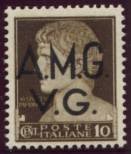
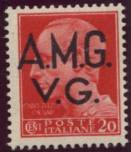
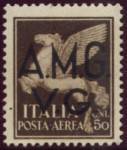

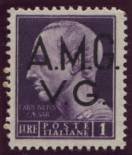
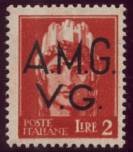
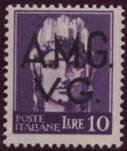
Immediately after WWII, the allies set up temporary governments in the liberated or conquered countries of western Europe, to run the countries until new, democratic governments could be set up. The organization that performed this function was the Allied Military Government, or AMG, which issued both currency and stamps for the transition period. In some cases, new stamps were created by overprinting existing stamps of the region. One example of this was in the part of Italy known as Venezia Giulia, which is on the Adriatic, on the border between Italy and what was then Yugoslavia.
(click here to view my separate page of information
about the AMG stamps.)
AMG-FTT


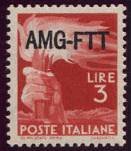
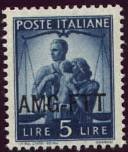

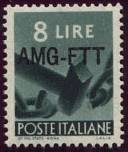




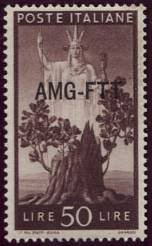
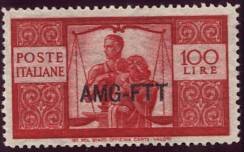
Venezia Giulia was eventually divided between Italy and Yugoslavia. During an interim
period, the Allies controlled the area known as the Free Territory of Trieste, for which
stamps were created by overprinting Italian issues with the text AMG-FTT.
(click here to view my separate page of information about the AMG stamps.)
VUJA-STT


Originals |


Overprints |
Overprint to change basic purpose of stamp


These postage stamps of Uruguay were overprinted with new values and text
to convert
them for usage as Parcel Post stamps.
Overprint to change value of stamp
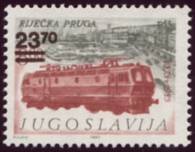
This Yugoslav stamps was overprinted even before it was issued ? a change in postage
rates made its original value obsolete.
Overprint as a security measure

Prevention of the theft and counterfeiting of stamps have always been major concerns for
Postal authorities in the US. One experiment towards reducing theft was the Kansas-
Nebraska overprints of 1929. The then-in-use definitive issues were overprinted with
Kans. for sale and use exclusively in the state of Kansas, and with Nebr. for Nebraska.
The effort was deemed a failure, probably because it was too costly and not very well
conceived, and was discontinued after initial supplies sold out. This is one of only two
occasions that overprints have been used for US postage stamps.
Ironically, the Kansas-Nebraskas themselves have been counterfeited extensively in the
years since their issue, not to defraud the Postal Service, but to cheat collectors.
The overprints were applied to the then-current stamps in use in the rest of the country,
which were and are quite plentiful, so even today it's easy to find the un-overprinted versions
and add one's own imitation of the overprint. It's well worth the effort, because
even the low values of the sets are worth a lot more than their common cousins (dollars
vs. cents). The example above is a counterfeit, though it
takes expert knowledge and fairly careful examination to detect the fakery. See Q is for Quality for more about the topic of fakes
and forgeries.
US Commemorative Overprints of 1928
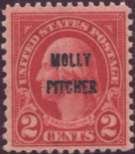
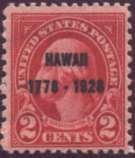

As an economy measure, the US Post Office overprinted existing definitives in 1928 to
create three commemoratives: The Battle of Monmouth Issue (Molly Pitcher), and the two
stamps of the Hawaii Sesquicentennial issue. The concept was universally scorned, and
has not been tried again. This is one of only two times US postage stamps have been
created by overprinting. (The other was the Kansas-Nebraska overprints described above.)
"Former Republics of the USSR" (Fantasies - Cinderellas)

When the USSR broke up, many of its constituent members found themselves short on
resources to produce new stamps, so they applied overprints to existing stocks of USSR
stamps. The true overprints were fairly crude and boring, but unscrupulous parties took
advantage of the confusion, and of the trusting nature of collectors, and created bogus
overprints for imaginary countries. The overprints above are such. To enhance their
appeal to topical collectors, many different themes and designs were used, e.g. trains,
ships, flowers, dinosaurs. Unfortunately, There are no such countries as Dagestan and
Eastern Siberia (they are member republics of the Russian federation, and do not issue
their own postage stamps), so these qualify as
Fantasies or Cinderellas.
Sole Canadian Commemorative Overprint
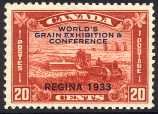
This is the only Canadian commemorative overprint - presumably the reaction there was similar to that in the US and they decided the concept should not be repeated. There have been many definitive overprints, however - Here is a brief list of all the Canadian overprints I know of at present:
(Thanks to Ian Billings and Yann Lovelock for that list - if you know of others, please e-mail me at posterstampcc@gmail.com1899 surcharges 2c / 3c
1915 WAR TAX overprint on 5, 20, 50c
1926 2c surcharges on 3c
1932 6c / 5c and 3c / 2c
1932 Ottawa Conference commemorative overprint and surcharge
1939 20c Special Delivery stamp surcharged 10c
1949-50 official stamps overprinted OHMS
1964 8c/7c airmail.
Numerous definitives overprinted 'G' for official use
Overprint - Korea, end of WWII
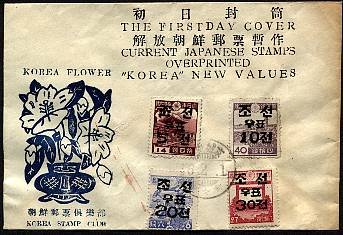
Korea was occupied by Japan during WWII, and made to use Japanese stamps for postage - this First Day Cover commemorates the release of the first Korean stamps after Independence. They were simply overprints of the Japanese stamps, the quickest and easiest way to create postage, but this FDC hints at the deep emotions involved.
3/13/3002 - A viewer writes as follows:
He is correct, of course, and I glossed over a lot of history in the interest of brevity and impact.You made a big bloomer on the postal history of Korea. It began issuing as the Kingdom of Korea in 1884 and declared itself an empire 1n 1897 at the very moment China, Japan and Russia were all scrambling to take it over. When Japan whipped Russia in 1905 it forced the Korean postal system to merge with the Japanese (and use its stamps) and formally annexed the country in 1910. By the time Japan entered WW2, therefore, Korea had been part of the Japanese empire for 30 years!
Spanish Overprint - Special Delivery

I'm including this one simply because it's such an attractive stamp.
"URGENTE" designates the stamp for Special Delivery postage.
| Home | N is for Numerals <<< | Contents | >>> O is for Overfrank | Credits |
All text Copyright © 2000, William M. Senkus
Send feedback to the webmaster: CLICK HERE
Revised -- 03/03/2003
